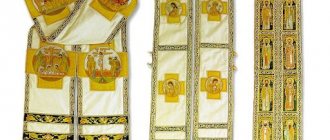When we talk about a cathedral, we always need context to understand what we are talking about. A cathedral is both an icon and a council of Christians (Ecumenical Council, Local Council and any other church council), and an institution (for example, the Zemsky Sobor) and a building.
Today we will talk about architecture. We all admired the most beautiful spiers of European cathedrals, went to church, read about wonderful ancient temples. And everything seems clear, until you think about it, what exactly is the difference between a church and a temple and a cathedral? You can't say that right away. But one thing is for sure - the cathedral, it seems big. Or is this only when it is a cathedral? Such confusion! It's time to put everything in its place.
A temple is a building for religious activities
Let's start with the simplest and most basic definition. It will help us bring out the rest.
A temple is an architectural structure for religious activities. Rituals are performed there, sermons are read, blessings are given, and many other things are done, depending on the characteristics of the culture. And these buildings are very different from each other.
In Japan, for example, there are hundreds of thousands of temples, and many of them look more like ordinary altars than full-fledged buildings. The Jews have one temple - Jerusalem, now it is destroyed, and there cannot be another.
Almost always, the temple reflects the realities of the spiritual world: the attention of visitors should be attracted by sculptures and paintings with higher beings and mythological subjects.
The temple is a place of communication between two natures, earthly and heavenly.
Holy Kazan Church (Syktyvkar)
In addition to the main function, the temple can often have auxiliary ones:
- Be a financial center.
- Serve as a building for public events.
- Act as a venue for celebrations and special ceremonies.
Etc., based on the realities of culture and time.
In Orthodoxy, a temple is a building where:
- there is an altar with a chapel;
- celebrate the Eucharist.
3 zones
This is how much there should be in an Orthodox church
According to the Old Testament tradition, the temple is divided into three parts:
- The altar in the temple is the most sacred place. It is believed that this is where the concentration of spiritual forces is located. In the altar there is a chapel - a table on which there is a plate with a sewn-in particle of the relics of a saint. According to tradition, the one in whose honor the temple is consecrated. The altar is separated from the rest of the temple by an iconostasis.
- Naos (katholikon) is the main space of an Orthodox church. Parishioners gather here. Naos has many areas that are decorated with wall paintings and icons. There are traditions about where and what images should be located.
- The narthex is the area under the bell tower and the porch adjacent to it. The least sacred place in the temple, so to speak.
And the temple may also have, for example, a basement, a second floor, a bell tower - but these are additional things, they are not required.
Church and temple are synonymous, but in some contexts “church” is a broader concept
We got an idea of the Orthodox church. How is the church different? Only etymology.
The temple comes from the word “mansions,” and the word “church” is of Greek origin and is translated as “house of the Lord.” In fact, these are synonyms. Almost.
Church of the Ascension of the Lord (Karinka village)
The word church is a multi-valued concept. It still has more than one definition. Church is:
- the entire body of Christians;
- any denomination (Catholic Church, Orthodox Church, etc.);
- Christian organization (Russian Orthodox Church, Russian Orthodox Church Abroad);
- people coming to an Orthodox church;
- religion-monopoly on the territory of the state (Islam in Muslim countries, Christianity in the Roman Empire);
- the name of some religious societies (Church of Satan, Mormon Church).
Therefore, when we say “church,” we can mean the clergy, Christianity in general, and the Russian Orthodox Church. It all depends on the context.
The meaning of the word "church" depends greatly on the context.
But in terms of building, church is synonymous with temple. And yet there is a very deep, semantic difference between a temple and a church:
- A temple is an architectural term, namely a building.
- A church is an indication of the religious status of a place and the participation of believers in its life.
Literature
- [etymolog.ruslang.ru/index.php?act=xi-xvii Dictionary of the Russian language XI-XVII centuries. Vol. 23 (Sj—smoke)] / Ch. ed. V. B. Krysko. - M.: Nauka, 1996. - P. 77. - 253 p. - (Russian Academy of Sciences. Institute of Russian Language). — ISBN 5-02-011208-9.
| A list of meanings of a word or phrase with links to relevant articles. If you came here from the text of another Wikipedia article, please go back and update the link so that it points to the correct article. |
__DISAMBIG__
There are also chapels, bell towers, refectories, etc.
There are a few more words whose meaning is often asked when it comes to temples and churches. Not all of these phenomena need to be on the same list. But since such a question arises, an explanation needs to be given.
The chapel is a miniature temple. There may be a bell tower, crosses, domes, icons. But liturgies are not celebrated there. It’s impossible because there is no throne. That is, it is an inferior temple, but also a religious building.
The chapel can be erected on a memorial site. Let's say, if some outstanding person died there, or a major disaster happened, or maybe, on the contrary, something miraculous happened.
Chapel of the Kazan Icon of the Mother of God (Irkutsk)
Often the chapel of a regular staff lacks a fence, and the buildings themselves are erected near cemeteries.
Theoretically, each chapel can become a full-fledged temple if it has a chapel and an altar. Small temples are sometimes called “chapel temples.”
A chapel can become a temple if an altar with a side chapel is made in it
The bell tower is a tall tower with a bell. May be a free-standing building. But not necessarily.
Bell tower of the Kazan Monastery (Tambov)
A belfry is a building with bells. It can also stand alone, or it can act as part of another structure. Unlike the bell tower, it is not a tower.
Belfry of the Rostov Kremlin
Refectory - a room for eating food. It can be a separate building on the territory of a temple or monastery.
Refectory of the Savvino-Storozhevsky Monastery
A monastery is a building or architectural complex in which monks (or nuns) live. On its territory there may be a cathedral, churches, bell towers, and refectories. There are also necessarily cells for living, and other structures are possible. A monastery is a synonym for a monastery. Lavra is the name of the largest, oldest and most influential monasteries.
Holy Bogolyubsky Convent
Chapel
Photo: Flickr.com
The chapel is also a temple, but small and without an altar. Due to the lack of the last attribute, liturgies are not held there. But services such as a memorial service or prayer service are often organized in the chapel, and hours - short services - are also held.
The chapels are located:
- at holy springs;
- at the cemetery;
- in places with the appearance of miraculous images.
A cathedral is the main temple of a city, district or monastery
Now about what a cathedral is. Firstly, a temple is no different from a cathedral. You cannot look at a building from the outside and confidently say: “This is definitely a cathedral.”
There are three cases when a building is called a cathedral:
Case 1. The cathedral is the main temple of the city . This is only a status, not a feature of the architecture.
How to choose the main temple? Sometimes it is built deliberately - large, beautiful, sublime, so that it sparkles and pleases the eye. Then the building may differ in both scale and interior decoration. And it’s not a fact that it will be possible to build such splendor. Whatever the funds are enough for, they will build it.
Alexander Nevsky Cathedral (Tallinn)
Or it may happen that the city has had a cathedral for a long time, but it is old, made of wood, built at the end of the 19th century. It seems that according to its status it should be big and beautiful, but after persecution from the Soviet regime the diocese did not get around to restoration.
It happens that if a city is large, then it has several cathedrals - one in each administrative part.
Case 2. The cathedral is the main temple of the monastery . Here, too, it is not a fact that the building will be large and luxurious. Almost every monastery suffered during the Bolshevik rule, was looted and partially destroyed.
Many monasteries live only on what they can earn themselves, and these funds are only enough for the most basic things needed for life. And therefore the main temple of the monastery may be in a state of disrepair.
Case 3. A cathedral is a building that is related to the bishop's see . It is either there or once was. So here, too, situations are not excluded when, instead of a huge cathedral, we can find a dilapidated church.
Excerpt characterizing the Council
Quite naturally, speaking about the situation in Prussia, Anna Pavlovna asked Boris to tell his journey to Glogau and the situation in which he found the Prussian army. Boris, slowly, in pure and correct French, told a lot of interesting details about the troops, about the court, throughout his story carefully avoiding stating his opinion about the facts that he conveyed. For some time, Boris captured everyone's attention, and Anna Pavlovna felt that her treat with a new product was received with pleasure by all the guests. Helen showed the most attention to Boris's story. She asked him several times about certain details of his trip and seemed quite interested in the situation of the Prussian army. As soon as he finished, she turned to him with her usual smile: “Il faut absolument que vous veniez me voir, [It is necessary that you come to see me,” she told him in a tone as if for some reasons that he couldn't know, it was absolutely necessary. – Mariedi entre les 8 et 9 heures. Vous me ferez grand plaisir. [Tuesday, between 8 and 9 o'clock. You will do me great pleasure.] - Boris promised to fulfill her wish and wanted to enter into a conversation with her when Anna Pavlovna called him away under the pretext of her aunt, who wanted to hear him. “You know her husband, don’t you?” - said Anna Pavlovna, closing her eyes and pointing at Helen with a sad gesture. - Oh, this is such an unfortunate and lovely woman! Don't talk about him in front of her, please don't talk about him. It's too hard for her! When Boris and Anna Pavlovna returned to the general circle, Prince Ippolit took over the conversation. He moved forward in his chair and said: Le Roi de Prusse! [The Prussian king!] and having said this, he laughed. Everyone turned to him: Le Roi de Prusse? - asked Ippolit, laughed again and again calmly and seriously sat down in the depths of his chair. Anna Pavlovna waited for him a little, but since Hippolyte decidedly did not seem to want to talk anymore, she began a speech about how the godless Bonaparte stole the sword of Frederick the Great in Potsdam. - C'est l'epee de Frederic le Grand, que je... [This is the sword of Frederick the Great, which I...] - she began, but Hippolyte interrupted her with the words: - Le Roi de Prusse... - and again, as soon as he addressed, apologized and fell silent. Anna Pavlovna winced. MorteMariet, a friend of Hippolyte, decisively turned to him: “Voyons a qui en avez vous avec votre Roi de Prusse?” [Well, what about the Prussian king?] Hippolytus laughed, as if he was ashamed of his laughter. - Non, ce n'est rien, je voulais dire seulement... [No, nothing, I just wanted to say...] (He intended to repeat a joke that he heard in Vienna, and which he had been planning to put all evening.) Je voulais dire seulement, que nous avons tort de faire la guerre pour le roi de Prusse. [I just wanted to say that we are fighting in vain pour le roi de Prusse. (Untranslatable play on words meaning: “over trifles.”)] Boris smiled cautiously in such a way that his smile could be classified as ridicule or approval of the joke, depending on how it was received. Everyone laughed. “Il est tres mauvais, votre jeu de mot, tres spirituel, mais injuste,” said Anna Pavlovna, shaking her wrinkled finger. – Nous ne faisons pas la guerre pour le Roi de Prusse, mais pour les bons principes. Ah, le mechant, ce prince Hippolytel [Your play on words is not good, very clever, but unfair; we are not fighting pour le roi de Prusse (i.e. over trifles), but for good beginnings. Oh, how evil he is, this Prince Hippolyte!],” she said.
Catholics and Protestants also have cathedrals
The difference between Catholic, Protestant and Orthodox cathedrals is primarily in architecture.
Catholic cathedrals are picturesque structures with many details. These buildings are impressive in size and imagination of the architects. Of course, not every cathedral is an outstanding masterpiece of architecture. In hearing and in sight - the best. They were built for many centuries and preserved during the years of unrest and wars in order to build something outstanding.
Protestant cathedrals are a little less elaborate. They are dominated by conciseness, accuracy, and great geometricity. But if you place a Catholic and a Protestant cathedral next to each other, it is not a fact that a random Orthodox Christian will accurately determine which is whose.
Cathedral of the Holy Apostles Peter and Paul - the building of the Lutheran Church
One of the reasons is different traditions. Catholics and Protestants coexisted within the Western Church, and Orthodoxy inherited the attributes of Byzantine culture. Accordingly, Russian churches are very different from the masterpieces of European architecture.
Both Catholics and Protestants call a cathedral a temple in which the episcopal cathedra is, was, or where it is temporarily located.
What is a cathedral and how is it different from a church?
There is probably no capital city that does not have a cathedral. Majestic buildings with domes, golden crosses and the smell of incense attract the attention of tourists and act as a spiritual refuge for believers.
Many people mistakenly think that a cathedral is the same as a church, but in fact there are many differences between these religious buildings. What is a cathedral? And what distinguishes it from the church?
What does the word "cathedral" mean?
If you look at Dahl's explanatory dictionary, you will see that the term “cathedral” came to us from the Old Church Slavonic language. The ancient Slavs understood the word “cathedral” as a meeting or congress at which all kinds of church issues were resolved.
History is well known for ecumenical, local and bishops' councils, where representatives of the clergy with the highest authority in religious doctrine took part. Over time, the building where such meetings took place began to be called a cathedral.
What is a cathedral?
In the modern understanding, a cathedral is the main church building of a city or monastic complex. Divine services in it can only be conducted by high clergy - archbishops, metropolitans, bishops.
The building receives this status from the ruling bishop, and often cathedrals are initially built as churches, and only over time become the main temples. The received status is not subject to revision, that is, even if the bishop moves to another building, the previous building still remains a cathedral.
In most cases, cathedrals are built large so that they can accommodate as many parishioners as possible. However, in its size it may not differ from a church, but services in it are conducted by priests of several churches.
It is generally accepted that the optimal staff is a rector and 12 clergy (according to the number of apostles), but in practice, in most cathedrals, especially Catholic ones, even on holidays there is only one clergyman.
What is a cathedral?
A cathedral is a religious building in which there is (or was previously present) a pulpit. The term “cathedra” comes from the Latin cathedra and means “throne, chair” in which the bishop sits. This place is considered the most honorable in the building and in Orthodox churches it is located near the eastern altar wall.
In Catholicism, it is customary to install the pulpit behind the altar - in the center or front of the presbytery, and in Anglican religious buildings - on the left side of the altar.
Episcopal thrones first appeared in early Christian churches. Their arrangement always correlated with the Gospel of John and implied imitation of the Lord and the 24 elders who sat near him.
On both sides of the pulpit were placed chairs for ordinary priests, with the result that the bishop in the center symbolically represented Jesus, and his assistants, respectively, the elders.
In addition to cathedrals, there are co-cathedral cathedrals, where there is another pulpit, and pro-cathedral cathedrals, which temporarily act as the main temple. In general, there are not many cathedrals, so they are all well known.
For example, in Moscow, St. Basil's Cathedral and the Cathedral of Christ the Savior have this status, in Paris - Notre Dame de Paris, in the capital of Germany - the Berlin Cathedral.
How is a cathedral different from a church?
A church is a religious building intended for religious ceremonies and prayers of parishioners. The main difference between a cathedral and a church is that it has a special status, which is assigned due to its position - the main temple or the meeting place of the bishop. Another difference is the presence of a see - a cathedral may or may not have an episcopal throne, whereas in a church one is never installed.
The size of a cathedral and a church can be the same, but most often they try to build cathedrals very large - with sufficient space for visitors, installation of choirs, a pulpit and church utensils.
Short definitions of non-architectural cathedrals
Since the topic is about cathedrals, it is worth explaining at least in general terms what else is called cathedrals:
A church council is a council of representatives of the Christian clergy. Comes in different sizes:
- The Ecumenical Council is the most important church council. Representatives of all Local Churches are present.
- A local council is a meeting of believers and clergy in any area.
- A council of bishops is a local council at which only bishops are present.
- The consecrated cathedral is a meeting of the leaders of the Russian Orthodox Church in the 15th–17th centuries.
Cathedral is the name of some church holidays (Cathedral of the Blessed Virgin Mary, Cathedral of All Saints)
The cathedral is an iconographic subject, which is characterized by the depiction of saints in groups.
Icon from the end of the 14th century to the beginning. XV centuries “Cathedral of Our Lady” from the Varvara Church (Pskov)
A cathedral is a representative body, for example, the Zemsky Sobor.
The cathedral church is an expression that implies that the church is open to everyone and always, that is, it always “gathers” everyone.
This is a pointer to the completeness and unity of the church.
Lexical meaning of the word "cathedral"
Science tries to understand concepts thoroughly so that there are no questions left. The lexical meaning of a word is understood, according to textbooks, as the image or phenomenon indicated by a set of sounds. And here we come to the same polysemy. After all, by the word “cathedral” our interlocutor can understand both a noun (temple) and a phenomenon (meeting). That is, the same term indicates essentially different things. On the one hand, it designates the building in which religious services are held, on the other hand, it calls for thinking about a congress of authorized representatives. It's up to the context to figure out what exactly is meant. For example, when you hear the phrase: “I visited an Orthodox cathedral during a tour,” imagine the building. Everyone understands that we are talking about a large temple, decorated with icons and frescoes. A different matter, for example, is the Zemsky Sobor. This phrase is an anachronism. Such events are not held today.










